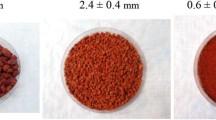Abstract
Bio-stimulated sealing technology is an interesting and promising technology for leakage repair in geotechnical engineering. Advancing studies of this technology have shown that some nutrients can be used to activate the metabolic process of in-situ soil microorganisms that induce bio-mediated sealing in a relatively short time. In this paper, we injected nutrient solution into sand columns with leakage and investigated the sealing mechanism. Two sand columns, each with a 2-cm diameter hole, were set up. One was treated with nutrient solution and the other received no nutrients as a control. The results showed that 900 mL of nutrient solution per day, with a concentration of 4.4 g L−1 potato extract solution, could notably decrease the volume of groundwater seepage. Finally, the volume of the seepage in the treated column was 0.85% of the control column. Evidence of micro morphological changes to the sand samples after the bio-stimulated sealing tests is given using the ESEM observations. Chemical element composition, organic and iron compound analyses were performed for an enhanced understanding of the underlying bio-stimulated sealing mechanism. The preliminary results obtained indicate that iron compound deposits, and organics (biomass and biofilm) produced during the sealing process near the leakage enhanced the sealing effect.
Similar content being viewed by others
References
Mitchell J K, Santamarina J C. Biological considerations in geotechnical engineering. J Geotech Geoenv Eng, 2005, 131(10): 1222–1233
Baveye P, Vandevivere P, Holye B L, et al. Environmental impact and mechanisms of the biological clogging of saturated soils and aquifer materials. Crit Rev Env Sci Technol, 1998, 28(2): 123–191
Ivanov V, Chu J. Applications of microorganisms to geotechnical engineering for bioclogging and biocementation of soil in situ. Rev Env Sci Biotechnol, 2008, 7: 139–153
Zhang H C. Experimental research of microbial-induced clogging in sands (in Chinese). Dissertation for the Master Degree. Beijing: Tsinghua University, 2010
Zhang H C, Guo H X, Li M, et al. Experiment research from macro to micro on microbial-induced clogging by adding potato soup in Beijing Sand Column. In: Proceedings of Geo Frontiers, ASCE, Dallas, 2011. 4089–4098
Blauw M, Beek V V, Willem van der Zon, et al. Biosealing, a biological sealing method for ground, is induced by mechanical weathering of ground particles due to fermentation. In: Proceedings of 1st International Conference BGCE, Delft, 2008. 14–18
Tanaka M, Fujiwara T, Kanayama M, et al. Sealing effect by adding nutrients on Japanese alluvial sand. In: Proceedings of 1st International Conference BGCE, Delft, 2008. 99–102
Lambert J, Veenbergen V, Ross N. Biosealing to reduce risks in tunnelling. Tunn Tunn Int, 2005, 37: 34–35, 37
Van Beek V M, Lambert J W M, Blauw M, et al. Application of biosealing for saltwater seepage reduction. 10th International Conference on Soil-Water System, Milano, 2008
Knight L, Novakowski K, Ramsay J. Biostimulation of groundwater microorganisms in fractured bedrock through nutrient addition: a field trial. In: Proceedings of 1st International Conference BGCE, Delft, 2008. 67–75
Tsinghua University. A repairing method to seal the buried concrete crack (in Chinese). Patent ID: 201010567414.4
Kang S B. Experimental research of microbial-induced clogging in sands through the buried cracking concrete block(in Chinese). Dissertation for the Bachelor Degree. Beijing: Tsinghua University, 2010
Li M. Mechanism of microbiology induced biogrouting and biosealing in civil engineering (in Chinese). Report for Post-Doctor. Beijing: Tsinghua University, 2011
Specification of Soil Test (SL237-1999) (in Chinese). Ministry of Water Resources, P R China, 1999
Lu R K. Chemical Analysis Method of Agricultural Soil (in Chinese). Beijing: China Agricultural Science and Technology Press, 2000. 60–71
Author information
Authors and Affiliations
Corresponding author
Rights and permissions
About this article
Cite this article
Guo, H., Cheng, X. & Li, M. Experimental analysis of bio-stimulated sealing process in environmental geotechnical engineering. Sci. China Technol. Sci. 56, 732–738 (2013). https://doi.org/10.1007/s11431-012-5103-3
Received:
Accepted:
Published:
Issue Date:
DOI: https://doi.org/10.1007/s11431-012-5103-3




